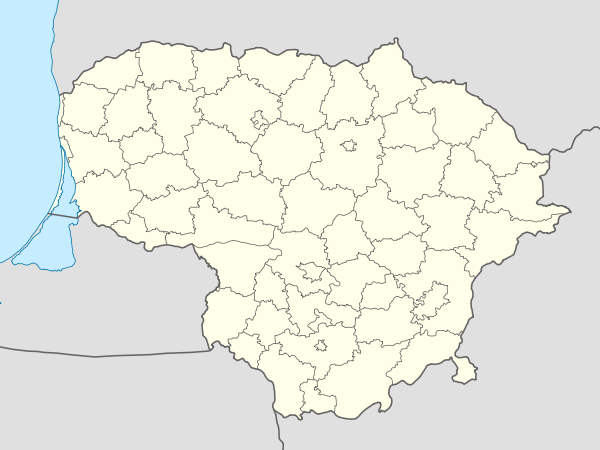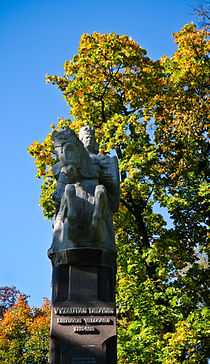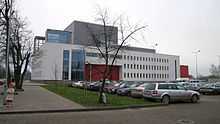Marijampolė
| Marijampolė | |||
|---|---|---|---|
| City | |||
|
Marijampolė Basanavičius square | |||
| |||
| Nickname(s): Miami of Lithuania (unofficial) | |||
 Location of Marijampolė | |||
 Marijampolė Location of Marijampolė | |||
| Coordinates: 54°32′50″N 23°21′00″E / 54.54722°N 23.35000°ECoordinates: 54°32′50″N 23°21′00″E / 54.54722°N 23.35000°E | |||
| Country |
| ||
| Ethnographic region | Suvalkija | ||
| County | Marijampolė County | ||
| Municipality | Marijampolė municipality | ||
| Eldership | Marijampolė eldership | ||
| Capital of |
Marijampolė County Marijampolė municipality Marijampolė eldership | ||
| First mentioned | 1667 | ||
| Granted city rights | 1792 | ||
| Government | |||
| • Type | Mayor-Council | ||
| • Mayor | Vidmantas Brazys (LSDP) | ||
| • City Council |
Councilmembers
| ||
| Area | |||
| • City | 21 km2 (8 sq mi) | ||
| Elevation | 86 m (282 ft) | ||
| Population (2015) | |||
| • City | 58,027 | ||
| • Density | 2,800/km2 (7,200/sq mi) | ||
| • Metro | 69,290 | ||
| Time zone | EET (UTC+2) | ||
| • Summer (DST) | EEST (UTC+3) | ||
| Postal code | 68001 | ||
| Area code(s) | (+370) 343 | ||
| Website |
www | ||
Marijampolė (![]() pronunciation ; also known by several other names) is an industrial city and the capital of the Marijampolė County in the south of Lithuania, bordering Poland and Russian Kaliningrad oblast, and Lake Vištytis. The population of Marijampolė is 48,700 (2003). It is the Lithuanian center of the Suvalkija region.
pronunciation ; also known by several other names) is an industrial city and the capital of the Marijampolė County in the south of Lithuania, bordering Poland and Russian Kaliningrad oblast, and Lake Vištytis. The population of Marijampolė is 48,700 (2003). It is the Lithuanian center of the Suvalkija region.
Marijampolė is the seventh largest city in Lithuania, and has been its regional center since 1994. The city covers an area equal to 205.07 square kilometres (79.18 sq mi). The Šešupė River divides the city into two parts which are connected by six bridges.
Names
The city has also been known as Marijampolis, Mariampole, Starapolė, Pašešupiai, Marjampol, Mariyampole, and Kapsukas.[1]
History
![]() Polish–Lithuanian Commonwealth 1667–1795
Polish–Lithuanian Commonwealth 1667–1795
![]() Kingdom of Prussia 1795-1807
Kingdom of Prussia 1795-1807
![]() Duchy of Warsaw (
Duchy of Warsaw (![]() First French Empire) 1807-1815
First French Empire) 1807-1815
![]() Russian Empire, Congress Poland 1815–1915
Russian Empire, Congress Poland 1815–1915
![]() German Empire 1915-1918 (military occupation)
German Empire 1915-1918 (military occupation)
![]() Kingdom of Lithuania 1918
Kingdom of Lithuania 1918
![]() Republic of Lithuania 1918-1940
Republic of Lithuania 1918-1940
![]() Soviet Union 1940–1941 (military occupation)
Soviet Union 1940–1941 (military occupation)
![]() Nazi Germany 1941-1944 (military occupation)
Nazi Germany 1941-1944 (military occupation)
![]() Soviet Union 1944–1990
Soviet Union 1944–1990
![]() Republic of Lithuania 1990–present
Republic of Lithuania 1990–present

.jpg)
The settlement was originally founded as a village called "Pašešupė" (in Polish: Poszeszupie), after the nearby river of Šešupė. As such the town was first mentioned in 1667. In the 18th century the village, at that time belonging to the Catholic Church, grew to become a market town and its name was changed to Starpol or "Staropole", after a new village built for Prienai starost's guards in the vicinity in 1739.[2] The settlement was destroyed by a fire in 1765.
After the disaster the wife of contemporary starost of Prienai, Franciszka Szczukowa née Butler, financed a new church and a monastery for the Congregation of Marian Fathers.[2] Following the foundation of the monastery, a new town was built in the area. It was named "Maryampol", after the Blessed Virgin Mary (Marya-), with the suffix -pol denoting a town.[3]
On February 23, 1792 King Stanislaus Augustus of Poland granted the "townlet of Mariampol" with Magdeburg Law and a privilege of market organisation. Following the Partitions of Poland the town was briefly part of Prussia. However, after the Napoleonic Wars it was restored to the Kingdom of Poland. In the 19th century the town continued to grow, mostly thanks to a large number of Jewish and German settlers. In 1817 the town became the seat of a separate powiat within the administrative system of the kingdom.[2] In 1827 the town had 1759 inhabitants. By 1861 the number had grown to 3718, 3015 of them being Jewish.[2] A fire consumed many wooden homes in 1868. As a result, many houses were rebuilt of stone.[4]
Following the January Uprising and the Russian suppression of the former Commonwealth lands, the powiat of Maryampol was seriously diminished.[2] Around that time also the monastery gained prominence as it was the only monastery owned by the Marians that was not closed down by the tsarist authorities.[5] As the surroundings of the town were primarily inhabited by Lithuanians,[2] the town became the centre of the Lithuanian national revival. The proximity of the Prussian border made the smuggling of books in Lithuanian language, banned in Imperial Russia, easier. Among the most notable Lithuanian scholars and writers active in Mariampol at that time were Kazys Grinius, Jonas Jablonskis, Vincas Kudirka and Antanas Venclova.
Following World War I the town became part of Lithuania and was renamed to its current name. During World War II the town was occupied by Germany. On 1 September 1941, somewhere between 5,000 and 8,000 Jews from Marijampolė, Kalvarija and elsewhere - along with people from other backgrounds - were murdered. Their bodies were placed in mass graves near the Sesupe River. Most of the murderers were Lithuanian.[4][6] In the effect of the war the town was heavily damaged and almost emptied. After the war it was rebuilt and repopulated with immigrants from other parts of Lithuania. Currently in Marijampolė, roughly 95% of its inhabitants are Lithuanians, with 4% being Russians and less than 1% being Poles.
On April 9, 1955 the authorities of the Lithuanian SSR once again renamed the town, this time to "Kapsukas", after a Lithuanian communist politician Vincas Mickevičius-Kapsukas.[7] The old name was restored after Lithuania regained her independence.
The Anshe Sholom B'nai Israel synagogue in Chicago, Illinois was founded by immigrants from Marijampolė. Other Jewish migrants from Marijampolė settled in Manchester, England.
Transport
Marijampolė is accessible by railway, Kaunas-Šestokai-Alytus line. Marijampolė is located at the crossroads of two highways. The Via Baltica connects Helsinki with Central and Southern Europe. The other highway links the city of Kaliningrad with Minsk.
Industry
Marijampolė is connected to its partners by business, sport, education, tourism, and other ties. Marijampolė's local means of mass media include a local television station, a local radio station, the newspapers "Marijampolės laikraštis", "Suvalkietis", "TV savaitė", "Sugrįžimai", and magazine "Suvalkija". Culturally, Marijampolė enjoys one cinema and a municipal drama theater.

Marijampolė is a regional centre of light industry enterprises, construction, transport and trade.
Education


Marijampolė has a strong educational system with state education institutions: 9 pre-school institutions, 6 nursery schools, 1 primary school, 12 lower secondary schools, 9 secondary schools, 3 gymnasium, a youth school, an adult education center, 5 additional training establishments, 3 non-state education institutions, a music school of Christian Culture, gymnasium of Marijonai, and R.Vosylienė languages school.
Marijampolė municipality
Marijampolė has a City Council with 27 members. The members of the City Council represent different Lithuanian political parties.
The municipality of Marijampolė is adjacent to the Vilkaviškis district municipality in the west, Kazlų Rūda municipality in the north, Kalvarija municipality in the south, and the Prienai district municipality and Alytus district municipality in the east.
The town of Marijampolė and its 6 surrounding communities make up the territory of Marijampolė municipality. They are: Gudeliai, Igliauka, Liudvinavas, Marijampolė, Sasnava, and Šunskai communities. Marijampolė municipality covers 755 square kilometres (292 sq mi) of land; 72% of which is an agricultural area, 12.3% is covered by forests; 4.2% – towns and villages, 2% – industrial enterprises and roads, and 6.9% – area used for other purposes.
International partners
Marijampolė is twinned and co-operating with:[8]
 Suwałki, Poland
Suwałki, Poland Piotrków Trybunalski, Poland
Piotrków Trybunalski, Poland Rogozno, Poland
Rogozno, Poland Bergisch Gladbach, Germany
Bergisch Gladbach, Germany Chernyakhovsk, Russia
Chernyakhovsk, Russia Kokkola, Finland
Kokkola, Finland Kvam, Norway
Kvam, Norway Viborg, Denmark
Viborg, Denmark
Notable people
- Moshe Rosenthalis (1922-2008), Lithuanian-Israeli painter
- Witold Teofil Staniszkis, Polish politician
- Violeta Urmana, Lithuanian diva, an honorary citizen of the city
- Darius Songaila, basketball player
Notes and references
- ↑ Library of Congress Authority control Name Headings. HEADING: Marijampolė (Lithuania). Accessed 2009-09-14.
- ↑ 2.0 2.1 2.2 2.3 2.4 2.5 various authors (1885). Filip Sulimierski, Bronisław Chlebowski, Władysław Walewski, ed. Słownik geograficzny Królestwa Polskiego i innych krajów słowiańskich (in Polish) VI. Warsaw: Wł. Walewski. p. 146. Retrieved 2008-08-29.
- ↑ Cognate with the Greek suffix -polis. The modern Lithuanian name of the town also follows the same etymology. It is to be noted that there are at least ten settlements of the same name in modern Poland, Ukraine and Belarus, all sharing a similar etymology.
- ↑ 4.0 4.1 Translation of the Marijampolė chapter from Pinkas Hakehillot Lita>
- ↑
- ↑ The Jaeger Report
- ↑ (Lithuanian)
- ↑ "Sister cities". Retrieved 4 May 2014.
External links
| Wikimedia Commons has media related to Marijampolė. |
| ||||||||||||||||||||


